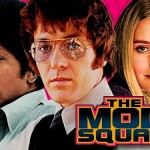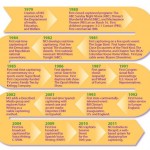At the First National Conference on Television for the Hearing Impaired in 1971, two possible technologies for captioning television programs debuted. Both technologies displayed the captions only on specially equipped sets for deaf and hard-of-hearing viewers. Another demonstration of closed captioning followed at Gallaudet College (now Gallaudet University) on February 15, 1972. ABC and the National Bureau of Standards presented closed captions embedded within the normal broadcast of “The Mod Squad.”
The Mod Squad!! Solid!! The very first captioned television commercial was for IBM.
Although closed captioning service was still an experimental technology, programs with “open” captions aired on PBS. In 1972, “The French Chef” made history as the first television program accessible to deaf and hard-of-hearing viewers.
ABC also began rebroadcasting its national news program on PBS five hours after its broadcast on ABC-TV. When “The Captioned ABC News” began in 1973, it offered the only timely newscast accessible to deaf and hard-of-hearing viewers, and it would remain so for nearly a decade.
Washington’s public television station, WETA, successfully tested the closed captioning system in 1973 using line 21 of the television signal. Galvanized by these successful tests, the Federal Communications Commission (FCC) reserved line 21 for the transmission of closed captions in the United States in 1976. With the FCC’s approval, PBS engineers innovated the caption editing consoles that would be used to caption prerecorded programs, the encoding equipment that broadcasters and others would use to add captions to their programs, and prototype decoders.
Remember the size of those decoder boxes? Not as huge as the original TTYs, but still…
In the final developmental stages at PBS, participants realized that securing the cooperation of commercial television networks required a nonprofit, single-purpose organization with a specific mission to perform this captioning.
And so, in 1979, we see the birth of The National Captioning Institute. NCI’s mandate: to promote and provide access to television programs for the deaf and hard-of-hearing community through closed captioning technology. The accomplishments of the new nonprofit would prove even more transformative than anyone could have imagined.
Our own Bill Pugin (President / CEO of The Sign Language Company) was recruited away from his captioning job at Gallaudet in 1979 to join The Nation Captioning Institute in Los Angeles. Bill had been captioning films and videos for Gallaudet’s library and NCI found him there. Those High School typing classes were paying off!
In 1980, there were only three captioned home video titles. Today, closed captions and subtitles are standard across the spectrum of home media, including virtual formats like online and digital media.
The closed-captioned television service caused an overnight sensation. Suddenly, everyone who had been shut out from the world of broadcast media could enjoy television programs along with hearing people. Television viewers looked forward to even more accessible programming, including prime-time series, soap operas, talk shows, game shows, sports, children’s programming, cartoons, and home videos–the same rich and wide variety of programming that hearing people take for granted. They wanted instant access to live programs such as national and local newscasts.
In 1982, NCI developed real-time captioning, a process for captioning newscasts, sports events, and other live broadcasts as the events are being televised, thereby bringing thousands of households into national conversations in a way that had previously been impossible. In real-time captioning, stenographers who have been trained as captioners type at speeds of up to 250 words per minute (!!!) to give viewers instantaneous access to live news, sports, and information. The viewer sees the captions within two to three seconds of the words being spoken.
And then the “chip”.
New Standards
With new technologies and methodologies in development, NCI focused on how to make the technology as widespread as the audience. NCI partnered with ITT Corporation to develop the first caption-decoding microchip. This chip could be built directly into new television sets in the factory, and it led to the passage of the Television Decoder Circuitry Act in 1990, mandating that all new television sets 13 inches or larger manufactured for sale in the U.S. contain caption-decoding technology.
1990 – Mandatory caption-decoding technology for all new U.S. made televisions (13” and larger)
1990 – Americans with Disabilities Act prohibits discrimination against persons with disabilities in employment, state and local government services, businesses that are public accommodations or commercial facilities, and in transportation. Title III of the ADA requires that public facilities, such as hospitals, bars, shopping centers and museums (but not movie theaters), provide access to verbal information on televisions, films or slide shows. Captioning is considered one way of making such information available to people who are deaf or hard-of-hearing. Federally-funded public service announcements also must be captioned.
1996 – Telecommunications Act of 1996 required that digital television receivers contain caption-decoding technology
2010 – The Twenty-First Century Communications and Video Accessibility Act requires broadcasters to provide captioning for television programs redistributed on the web and for HDTV-decoding boxes to include a button that controls closed captioning in the output signal.
2012 – the FCC also adopted rules establishing closed captioning requirements for programming delivered through the internet.
So what’s next? Here’s a holiday toast to The National Captioning Institute for their history, innovation and continuing efforts providing equal access and awareness around the world.















December 21, 2017
asl, deaf, Deaf Culture, entertainment